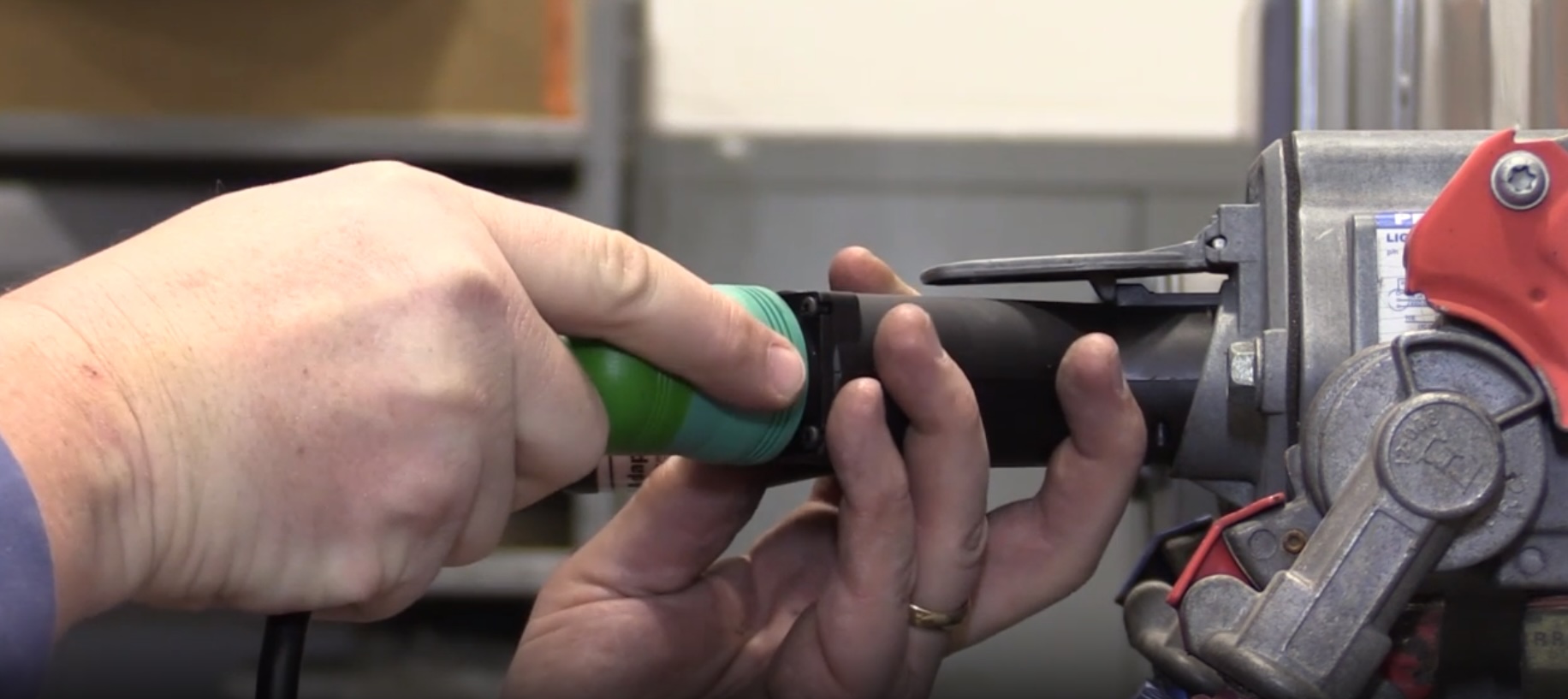Although wheel bearings are often the most neglected part of the vehicle, they nevertheless have a critical job to do, and in most cases, do it very well. Not only are wheel bearings designed to support the weight of the vehicle and allow it to travel over a road with a minimum of rolling friction, the bearings must also withstand the thrust loads generated by high-speed cornering and hard acceleration and braking. In addition, most wheel bearings must operate in a hostile environment ranging from 40 F on a cold start-up to more than 400 F during heavy braking. Worse still, the muddy, silt-laden water of Americas southern flood plains have recently ruined thousands of wheel bearings by contaminating them with dirt and water.
Its All Ball Bearings Nowadays
Ball-type wheel bearings were very popular on early vehicles because they were easy to manufacture and install. Moreover, since ball-type wheel bearings have minimal load-bearing area between the ball and the inner and outer bearing races, their rolling friction is usually low. On the other hand, this lack of load-bearing area makes adjustment and lubrication critical because a combination of too much preload and incorrect bearing grease will cause rapid failure.
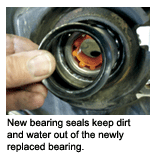 Rolling in the 50s
Rolling in the 50s
During the late 1950s, tapered roller wheel bearings became popular because the larger contact area between the roller and bearing races increased their load-bearing capacity and made them more reliable. The tapered roller bearing developed more rolling friction, which caused increased fuel consumption. Tapered roller bearings also provided superior performance because they could better withstand increased side thrust from high-speed cornering than ball bearing designs.
Improvements in the 80s
During the fuel-conscious 1980s, auto manufacturers began looking for ways to reduce rolling friction. Ball bearings were chosen for several different reasons. First, improved bearing and lubrication technology make ball bearings more durable. Second, engineers have designed precision-machined hubs that maintain precise clearances for maximum bearing life and maintenance-free performance.
Some modern imports use sealed wheel bearings made with barrel-shaped rollers, which combine the best features of the ball and roller bearing designs. Others use the classic ball bearing design to reduce friction and support the weight of the vehicle. Whatever the case, the sealed, maintenance-free wheel bearing has become the standard design for front and rear axles for import vehicles.
Bad Play
Worn wheel bearings usually cause excessive wheel bearing play, or cause a growling or knocking noise to occur at wheel speeds. In addition, worn front wheel bearings can cause excess pad-to-rotor clearance and a resulting low brake pedal on disc brake vehicles. Worn rear-wheel bearings with excessive play on live or solid rear axle gear assemblies may also cause the rear axle shaft to run off-center in the oil seal, which causes the oil seal to leak.
Excess bearing play can be detected by grasping the wheel at the 12 and 6 oclock positions and tipping it in and out. In general, sealed, ball and tapered roller wheel bearings shouldnt have more than 0.005 end play.
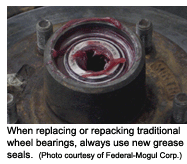 Making Some Noise
Making Some Noise
When diagnosing a wheel bearing noise, remember that noisy wheel bearings are often difficult to locate because the growling or knocking noise transfers through the axle, suspension, frame and vehicle body. When bearings are tested with the wheels in an unloaded position, the noise complaint usually disappears. Occasionally, rough bearings can be detected by carefully rotating the wheel by hand and listening for roughness or knocking.
Several methods can be used to determine the location of a noisy wheel bearing. Before diagnosing the noise, its important to drive the vehicle a few miles to warm up the bearing lubricant. In most cases, as the vehicle is rapidly steered from side to side in an empty parking lot, the noise increases as chassis weight is rolled onto the defective bearing. In other cases, a set of electronic ears can be placed on each axle assembly to pinpoint which wheel is making the noise.
As a last resort, the vehicle can be driven several miles at highway speeds to warm up the bearings. When the bearing temperatures are immediately tested afterward with a non-contact pyrometer, the bearing with the highest operating temperature is usually causing the noise. Keep in mind that in the instance of a live axle, a failed differential carrier bearing will also make the same type of noise as a failed outer axle or wheel bearing. In this situation, its important to inspect for bearing chips in the axle oil by passing a magnet through the used oil.
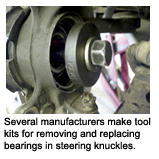 Race Inspections
Race Inspections
Remember that a bearing race surface is case-hardened for maximum durability. The base metal is made softer to allow enough elasticity for pressing the inner and outer bearing races onto shafts and into bearing bores. As the case-hardened surface flakes away, potholes form in the surface, which exposes the soft base metal underneath and causes the bearing grease to quickly become contaminated with metal chips.
A tapered roller bearing in good condition will show the original cross-hatch polish on the outer race. This polish will usually dull as the bearing wears into the base metal. The only exception to this rule is a preloaded tapered bearing running in oil, where its normal for the bearing races to exhibit a frosted appearance. If small dents appear in a bearing race, the bearing has been exposed to metallic debris. A dark-gray color on the outer race would suggest that the bearing has been exposed to water and should be replaced.
When replacing any wheel ball-type or tapered-roller bearing, its extremely important to replace the bearing and races as a complete unit. Mixing worn bearings and races will lead to early failure because in the case of a tapered-roller bearing, worn tapered rollers have become barrel-shaped and will not achieve full edge-to-edge contact when readjusted.
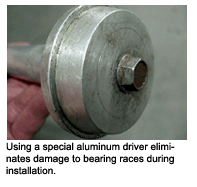 Greased Up
Greased Up
When choosing bearing grease, always follow the manufacturers recommendations. Many types of grease arent compatible due to different base chemistry. Mixing greases usually results in the greases liquefying and flowing out of the bearing. Unlike chassis grease, wheel bearing grease must tolerate high operating temperatures and severe loads without being squeezed out of the bearing. In addition, most bearing greases have a much higher tolerance for moisture than cheap chassis grease. Last, always install new bearing seals to prevent water and dirt from contaminating the bearing grease.
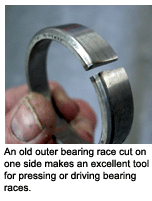 Installation Notes
Installation Notes
- To avoid damaging the new bearing, the bearing inner race must be carefully pressed onto a shaft and the outer race pressed into its bore. Hammering a bearing in place can result in the rollers or balls dimpling the bearing races and causing premature failure.
Most bearings have about 0.001 of interference-fit built into an axle shaft or bearing bore, which means that these types of bearings must be pressed or driven into place. Tapered bearing cups or outer races should be driven in place using a special aluminum driver. In an emergency, an old bearing race cut through on one side with an air-powered whiz wheel will serve the purpose.
Special tools are also available for pressing bearings into a steering knuckle. Installation of bearings into an aluminum steering knuckle or housing can be expedited by using an electric hot air gun to gradually expand the housing without melting or distorting the metal. Lastly, always adjust a tapered roller bearing by torquing to 15-20 ft.-lbs. and spinning the hub to center the rollers in the races. Back this initial adjustment off an 1/8 or 1/4 turn and retorque the bearing to manufacturers specifications. A typical final torque of 20-30 inch-pounds will leave zero end play and a slight amount of preload on the wheel bearing assembly.
Whether installing a ball, roller or sealed bearing assembly, using correct procedures and tools will ensure a comeback-free wheel bearing installation.


